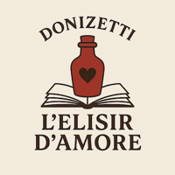
Overview
Synopsis
L’elisir d’amore follows Adina, the beautiful but fickle landowner, and Nemorino, the clumsy but lovable young man, through the ups and downs of their love story. Nemorino is madly in love with Adina, but Adina holds him at arm’s length, feigning indifference to tease him. Over and over again, he professes his love to her, but she tells him to move on. Adina teases him by pretending to marry the pompous Sergeant Belcore. Desperate, Nemorino purchases an “elixir” that will make Adina fall in love with him, which actually is red wine that simply makes him tipsy. Convinced that she will fall for him, he begins to pretend not to love her anymore, which causes Adina to act out of jealousy, moving the wedding forward. After many twists and turns, Adina finally realizes and confesses her love for Nemorino, and they rejoice with the town.
Show Information
Context
Gaetano Donizetti composed L’elisir d’amore in 1832 during a particularly fertile period in his career, balancing both comic and tragic works. The son of a poor Bergamo textile worker, Donizetti rose from modest beginnings to become one of the leading figures of bel canto opera. His sensitivity to the struggles of ordinary people, shaped by his own background, is reflected in the humble peasant Nemorino, who wins love not through status or wealth but through sincerity and persistence. This
to read the context for L'elisir d’amore and to unlock other amazing theatre resources!Plot
Act I
In the small Italian town, the peasants are taking a break from their work and gather around the rich and beautiful landowner, Adina, as she reads a book. Nemorino, the simple, clumsy young village man, listens and watches with complete adoration (Quanto è bella, quanto è cara). He loves Adina completely, but senses that she may be out of his league. The villagers all urge her to continue reading, so she reads them part of the story of Tristan and Isolde, and how Tristan won
to read the plot for L'elisir d’amore and to unlock other amazing theatre resources!Characters
| Name | Part Size | Gender | Vocal Part |
|---|---|---|---|
|
Lead |
Male |
Tenor |
|
|
Lead |
Female |
Soprano |
|
|
Lead |
Male |
Bass |
|
|
Supporting |
Male |
Baritone |
|
|
Supporting |
Female |
Soprano |
|
|
Chorus of Peasants, Children, and soldiers of Belcore’s platoon |
Ensemble |
Either Gender |
|
Songs
Act I
Act II
A song with an asterisk (*) before the title indicates a dance number.
Monologues
Scenes
Key Terms
An aria is a solo vocal piece in an opera or oratorio that showcases the singer’s range and emotional expression. It is typically performed with orchestral accompaniment and often marks a moment of reflection or emotional climax.
An operatic singing style emphasizing beautiful tone, phrasing, and technique, typical of 18th and early 19th-century Italian opera.
A cadence is a musical resting point that feels like punctuation in music, similar to a period or comma in writing. In opera, cadences signal when a phrase is finished or when a character’s thought has come to a pause. For example, in L’elisir d’amore, cadences are used to emphasize emotional moments in Nemorino’s singing or to neatly wrap up faster, comic passages
A comedic form of opera that developed in the 18th century, featuring everyday characters and humorous plots. It contrasts with the more serious opera seria.
Rapid and rhythmic speech or singing, often used in comic opera roles or musical theatre for humorous effect.
A style of vocal delivery in opera where the singer adopts the rhythms of ordinary speech. It advances plot between arias and provides narrative context.
Videos
Quizzes
Themes, Symbols & Motifs
Themes
Love vs. Illusion
At the heart of the
to read about the themes, symbols and motifs from L'elisir d’amore and to unlock other amazing theatre resources!Quote Analysis
“Una furtiva lagrima negli occhi suoi spuntò…”
to read our analysis of select quotes from L'elisir d’amore and to unlock other amazing theatre resources!